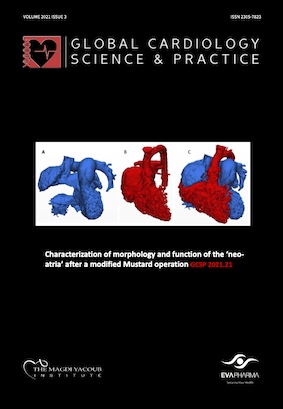Characterization of morphology and function of the ‘neo-atria’ after a modified Mustard operation
DOI:
https://doi.org/10.21542/gcsp.2021.21Abstract
Background: There is a pressing need to improve early and long-term results of the Mustard operation. A modification of the operation was introduced at the Aswan Heart Centre for this purpose which relies on creating new functional atria rather than the two rigid channels in the classical Mustard operation.
Objectives: To evaluate the morphology and function of the neo-atria, shortly after modified mustard operation for a ‘neglected’ patient with TGA, VSD and severe pulmonary hypertension.
Methods: A 6-year-old with neglected TGA, VSD and pulmonary hypertension presented with severe cyanosis, clubbing and haemoconcentration (Hb 22 g/dL), underwent the modified Aswan-Mustard operation (MAM) with rapid smooth postoperative recovery. Repeated 2D echograms and multi-slice CT scans, followed by 3D segmentation, were performed after the operation. The size, shape, and morphology of the neo-atria were measured and measurements of the patterns of instantaneous filling and emptying of the right and left ventricles were quantified.
Results: The neo-systemic venous atrium consisted of three components with a combined volume of 78 mL/m2, all of which contributed to the reservoir, conduit, and importantly contractile function of the neo-atrium. The pulmonary venous atrium consisted of two components with a combined volume of 66 mL/m2. These measurements were made at atrial end diastole. The volumes of the systemic venous and the pulmonary venous diminished to 51 and 54 mL/m2, respectively, at the end atrial systole - indicating relatively preserved contractile functions.
Downloads
Published
Issue
Section
License
This is an open access article distributed under the terms of the Creative Commons Attribution license CC BY 4.0, which permits unrestricted use, distribution and reproduction in any medium, provided the original work is properly cited.


